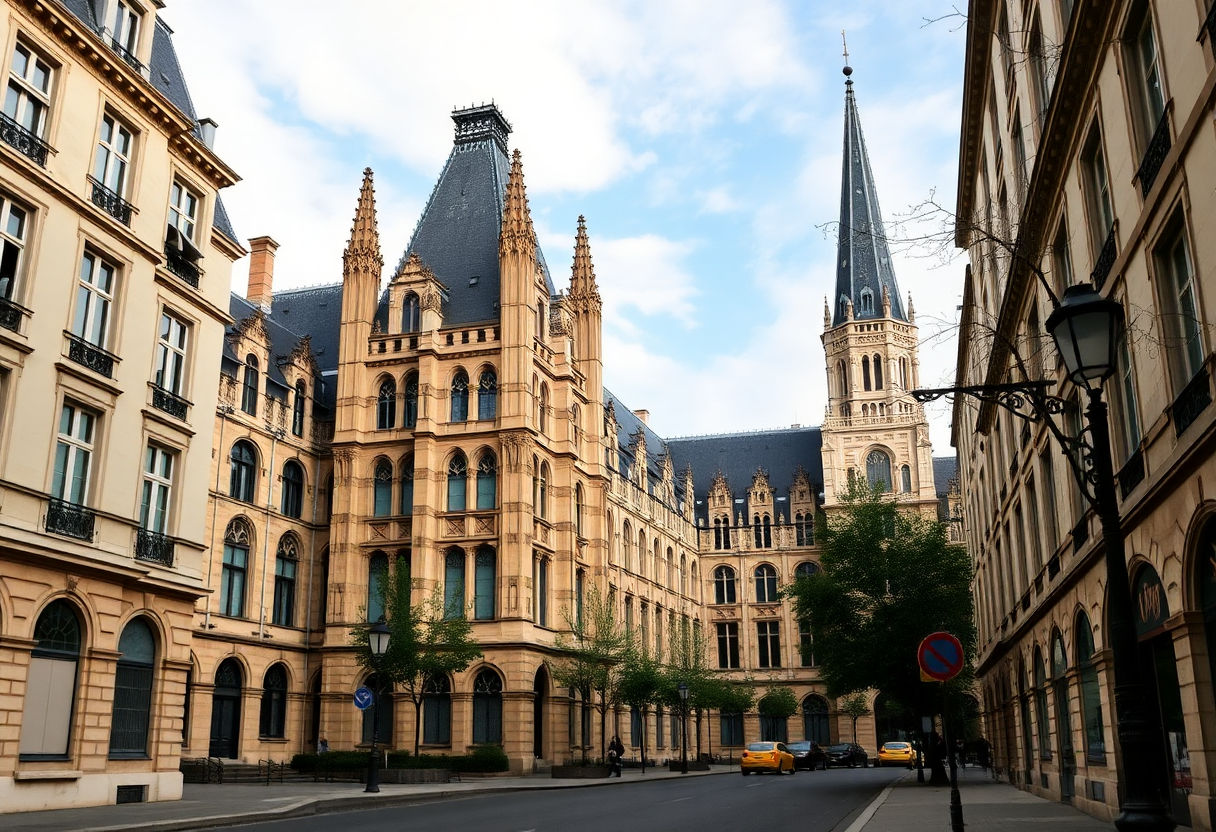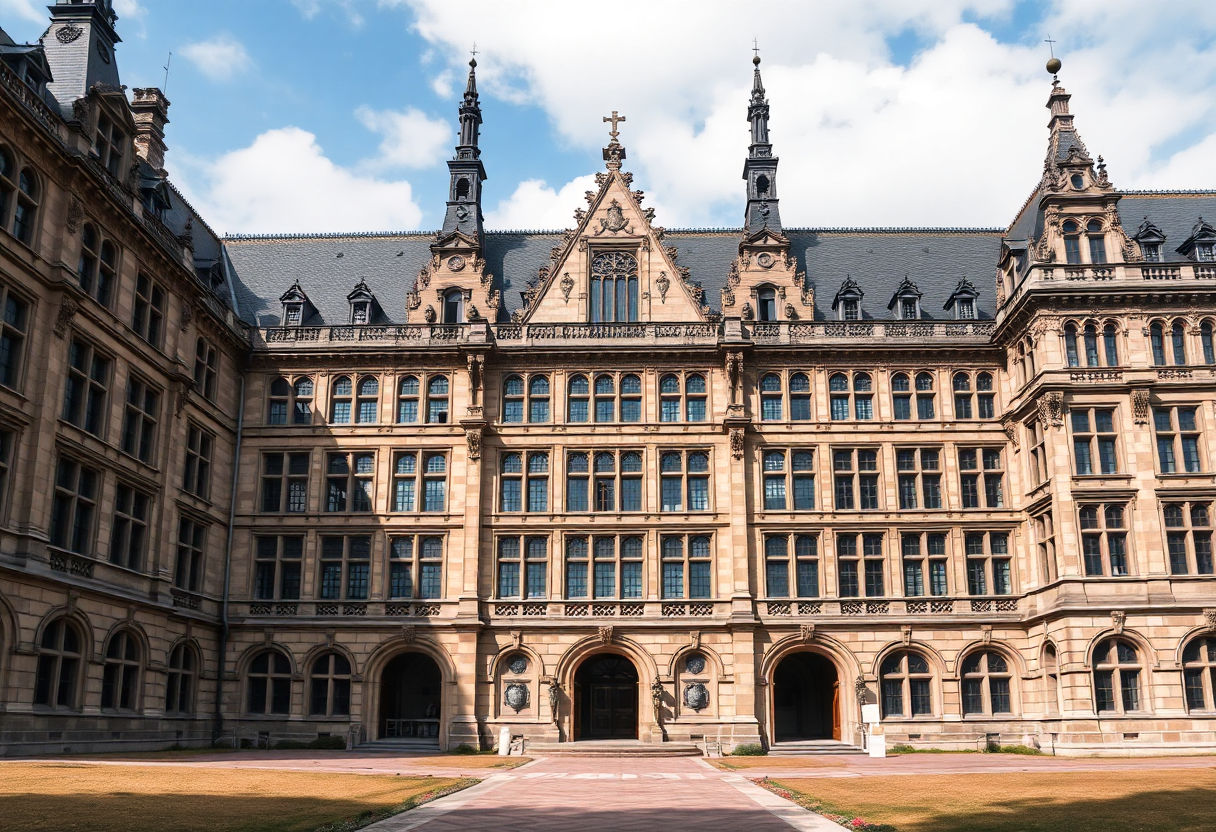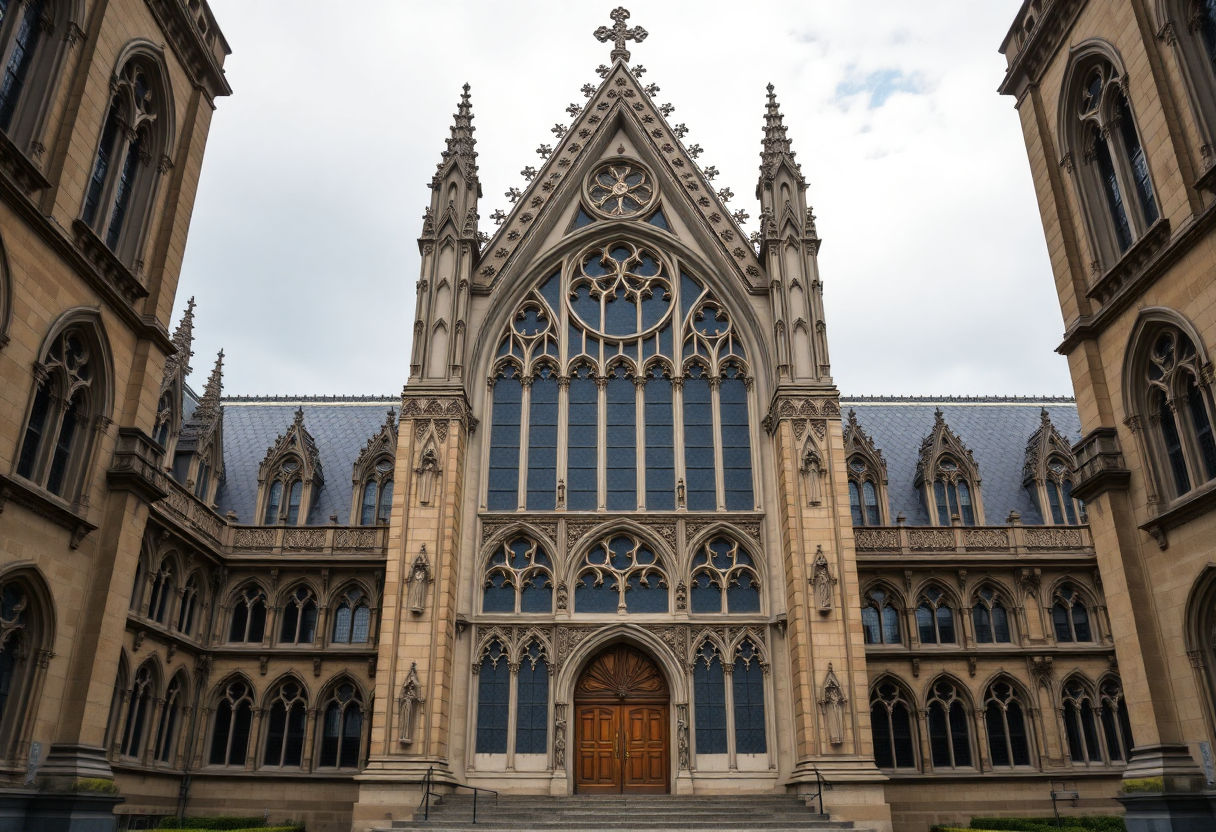The allure of European Dark Academia captivates with its dramatic fusion of Gothic architecture and intellectual pursuit. A journey across Europe’s most iconic universities unveils structures where dark, intricate designs meet centuries-old scholastic traditions. This article delves into universities such as Oxford, Cambridge, and the Sorbonne, whose aesthetic and cultural impact have shaped the philosophical framework of Dark Academia. Discover how these historical institutions foster a romanticized appreciation of classic literature and learning, inviting readers to explore a world where architectural splendor meets profound academic inquiry. Embark on this exploration of Gothic-inspired learning environments.
Key Takeaways
- Dark Academia is a cultural movement that marries the passion for learning with the aesthetic of Gothic architecture.
- Gothic universities in Europe, such as Oxford and Cambridge, are iconic for their history and architectural magnificence.
- The architectural development of Gothic elements in academia significantly influences the modern-day intellectual atmosphere.
- Gothic structures at universities like Heidelberg and Sorbonne enrich the educational environment with their historic grandeur.
- The Gothic architectural marvels at institutions such as the Technical University of Munich and the University of Edinburgh continue to inspire and shape Dark Academia culture.
The Essence of Dark Academia

Dark Academia is a cultural movement that finds its roots in the rich tapestry of classical education and Gothic romanticism. At its core, the subculture romanticizes the pursuit of knowledge, blending philosophical inquiry with an appreciation for the literature and art of the past. It is more than a mere aesthetic; it embodies a profound admiration for scholarly pursuits and the intellectual heritage of European institutions.
Central to the allure of Dark Academia is the reverence for the classics—ancient philosophies, classic literature, and timeless art forms. This respect manifests in rituals of learning, where reading by candlelight and drafting essays with fountain pens are cherished practices. The cultural movement echoes the sentiments of bygone intellectual eras, encouraging a life of reflection and introspection.
Dark Academia is also visually distinct, characterized by its love for the aesthetic appeal of Gothic architecture, muted color palettes, and vintage academia-inspired fashion. Key elements include ivy-covered university halls, dimly lit libraries lined with leather-bound tomes, and attire reminiscent of scholars from centuries past.
The philosophy underpinning Dark Academia emphasizes the importance of knowledge for personal growth, advocating for a disciplined and intentional pursuit of learning. Within this lens, the journey of education is as vital as its destination, with the pursuit of wisdom viewed as a lifelong endeavor.
In embracing both the beauty of intellectual rigor and the artistic expressions of history, Dark Academia offers a sanctuary for those who seek to merge their academic ambitions with an appreciation for the nuanced beauty of the past.
Historical Overview of Gothic Architecture in Academia

Gothic architecture has left an indelible mark on European academia, manifesting through iconic university buildings that tell stories of intellectual vigor and scholastic tradition. Emerging in the High Middle Ages, the Gothic style flourished between the 12th and 16th centuries, characterized by its pointed arches, ribbed vaults, and flying buttresses. These elements not only enhanced the structural integrity of buildings but also imbued them with a sense of verticality and light, symbolizing the pursuit of knowledge and the divine.
Education centers of the medieval period deeply integrated Gothic architectural elements to reflect their devotion to learning and religion. Many of the oldest European universities were established during this era, incorporating these architectural advancements. The majestic facades and cavernous interiors of these institutions provided a fitting backdrop for the profound academic activities that took place within.
The resonance of Gothic architecture in a learning environment transcends mere aesthetics; it fosters a milieu of contemplative excellence. This architectural legacy continues to be pivotal in modern academia, posing as a link between the historical pursuit of knowledge and contemporary educational values. In many institutions, the preservation and restoration of Gothic structures are actively pursued to capture and perpetuate their historical significance.
Today, Gothic architecture in academia is more than just a vestige of the past—it is a living tradition. Its continual influence can be observed in the architectural designs of modern university campuses that aim to evoke the same grandeur and academic gravitas as their medieval predecessors. The enduring appeal of these structures contributes significantly to the mystique of Dark Academia, offering a tangible connection to centuries of scholarly endeavor.
University of Oxford
Oxford University stands as a beacon of intellectual pursuit and Gothic majesty, a cornerstone of what defines European Dark Academia. Established in the 12th century, Oxford is among the oldest universities in the world, draped in a tapestry of history and tradition. Its architectural ensemble is a testament to the exquisiteness of Gothic design, blending academic integrity with aesthetic grandeur.
Prominent among Oxford’s Gothic structures is the Bodleian Library, with its pointed arches and intricate stone carvings that beckon the soul of the learned. The Radcliffe Camera, though Baroque in style, complements these Gothic surroundings with its grand circular form, embodying the spirit of scholastic inquiry and classic literature central to Dark Academia.
The University’s Great Hall at Christ Church, famed for inspiring the design of the Hogwarts dining hall, serves as a vivid illustration of the Gothic revival, echoing the opulence and solemnity that characterize Dark Academia’s appeal. The Divinity School, an architectural marvel from the medieval period, boasts a spectacular ceiling of stone ribs intertwining in a complexity resonant with the pursuit of knowledge and enlightenment.
These iconic edifices are more than mere structures; they symbolize a dedication to academic excellence and introspective learning. As a hub for critical thought and literary exploration, Oxford University encapsulates the essence of the Dark Academia aesthetic, where the convergence of Gothic architecture and deep intellectual tradition continues to inspire countless scholars and enthusiasts worldwide.
University of Cambridge

Cambridge University stands as a remarkable epitome of Gothic architecture, intertwined with the essences of Dark Academia. Founded in 1209, this venerable institution offers an enchanting atmosphere fostered by its medieval structures and scholarly legacy.
Prominent among its Gothic landmarks is King’s College Chapel, completed in 1544. The chapel is renowned for its stunning fan vaulting and elaborate stained glass windows, which portray biblical scenes in vibrant hues. Its intricate architecture serves as a beacon for students and visitors alike, inspiring contemplation and reflection.
The university’s buildings, such as St. John’s College and Trinity College, possess cloisters and courtyards designed in a Gothic Revival style that hark back to an era of intellectual exploration. These spaces offer a sense of seclusion and introspection, aligning with the Dark Academia ethos of blending academia with the poetic beauty of the past.
Moreover, many of the university’s libraries, like the Wren Library at Trinity College, house ancient manuscripts and rare books, evoking an atmosphere of scholarly pursuit and mystery. These historic materials, held within the Gothic confines of the library, serve as a tangible connection to centuries of academic tradition.
Cambridge’s Gothic architecture not only contributes to its aesthetic appeal but also reinforces its status as a bastion of knowledge, fostering an environment where students and faculty alike are encouraged to delve deeply into the annals of history and pursue intellectual enlightenment. Such a harmonic blend of academic rigor and architectural majesty continues to draw enthusiasts of Dark Academia from around the world.
Heidelberg University
Founded in 1386, Heidelberg University stands as Germany’s oldest university and a vibrant symbol of intellectual pursuit. Nestled in the scenic Neckar River valley, the university is renowned for its harmonious blend of Gothic and Renaissance architectural styles, which play a pivotal role in the Dark Academia aesthetic.
The university’s architectural landscape is a testament to the evolving styles of European academic structures. The Alte Universität, with its Gothic foundations, offers a glimpse into medieval scholastic traditions. Meanwhile, the transformation of architectural design over the centuries is evident in buildings like the Renaissance-style Marstall, originally serving as a horse stable, which today hosts modern student facilities.
Heidelberg University is not just lauded for its architectural magnificence but also for its scholarly contributions. It boasts a legacy of profound academic achievements, with its scholars influencing fields as diverse as philosophy, the sciences, and the humanities. Notable figures, such as philosopher Friedrich Hegel and poet Joseph von Eichendorff, have walked its halls, contributing to the rich tapestry of European thought.
“Academic freedom,” a principle highly valued here, encourages a vibrant exchange of ideas cultivating an atmosphere conducive to innovation and scholarly inquiry. This ethos of enlightenment resonates closely with the ideals of Dark Academia, which cherishes classic literature, critical thought, and the pursuit of knowledge.
A stroll through Heidelberg’s cobblestone streets and historic courtyards is an invitation to step back in time, offering students and visitors alike a profound connection to centuries of academic excellence and architectural beauty.
Sorbonne University

The esteemed Sorbonne University, nestled in the heart of Paris, offers a quintessential blend of Gothic architecture and historical allure that resonates with the Dark Academia aesthetic. Founded in 1257, Sorbonne stands as a symbol of scholarly pursuit, its history steeped in the pursuit of knowledge and intellectual freedom.
The Gothic influences at Sorbonne are prominently displayed in its architectural elements, such as the intricately crafted facades and soaring arches that echo the intellectual fervor and academic rigor associated with this venerable institution. The iconic chapel, rich with artistic embellishments, serves as a testament to the university’s longstanding tradition of melding sacred spaces with secular learning.
Sorbonne’s academic environment further enhances its Dark Academia appeal. The university boasts a vibrantly intellectual community where the study of the arts and humanities is paramount. Students are drawn to its extensive library collections, housed within spaces that encourage introspection and a profound connection to the classical texts often celebrated in Dark Academia culture.
Within Sorbonne’s hallowed halls, the spirit of Gothic tradition is not merely confined to its physical edifices but extends into the very core of its educational ethos. The integration of diverse scholastic disciplines fosters an atmosphere where historical inquiry and contemporary thought gracefully converge. This dynamic synthesis of past and present renders Sorbonne not only a bastion of learning but an enduring symbol of a romanticized academic tradition that continues to inspire learners worldwide.
Technical University of Munich

The Technical University of Munich (TUM), while renowned for its modern technical prowess, harbors elements of the Gothic architectural style that enrich its academic ethos. Founded in 1868, TUM showcases a blend of contemporary and historical influences, embodied through its diverse campus architecture.
One of the focal points of TUM’s Gothic allure is the historic Main Campus located in the heart of Munich. The facades echo Gothic intricacies, featuring pointed arches and ornate detailing that reflect the architectural transitions of the late 19th century. The design complements the university’s commitment to fostering an academic environment steeped in tradition yet forward-thinking in its approach to education and research.
TUM’s integration of Gothic design is strategic, aimed at inspiring both students and faculty by creating an atmosphere conducive to innovative thought, echoing the Dark Academia ethos. The university positions itself at the intersection of aesthetic grandeur and academic rigor, utilizing its architectural heritage as a backdrop for cutting-edge scientific endeavors.
The stark contrasts between the old and new are particularly evident in the interplay between TUM’s classic elements and those of its ultra-modern facilities, such as the TUM Institute for Advanced Study. Such juxtaposition underscores the university’s dynamic as a living entity that continually evolves while honoring its historical roots.
Incorporating Gothic elements into its sprawling campuses, TUM not only celebrates its past but harnesses these stylistic choices to inspire a future where technology and tradition interlace, making it a unique participant in the Dark Academia dialogue across Europe’s esteemed educational institutions.
University of Edinburgh
Nestled in the heart of Scotland’s capital, the University of Edinburgh boasts an impressive array of Gothic architectural masterpieces that serve as elegant testaments to its rich academic heritage. Founded in 1583, the university has long been a beacon of intellectual pursuit, entwined with a dramatic architectural flair that cements its place in the narrative of Dark Academia.
The Old College, a distinguished landmark of the university, stands as a quintessential example of Gothic Revival architecture. Its imposing facade, intricate ribbed vaults, and pointed arches convey a sense of grandeur, embodying both the aesthetic and the ethos of Dark Academia. The Playfair Library Hall within the Old College exemplifies this further with its stunning central reading area and vaulted ceilings, designed to inspire and promote the pursuit of knowledge.
A stroll through the university campus reveals a plethora of Gothic delights, including the iconic McEwan Hall. Known for hosting the university’s graduation ceremonies, McEwan Hall’s elaborate dome and ornate interior symbolize the ceremonial grandeur prevalent in Gothic architecture.
Beyond its architectural allure, the University of Edinburgh is a cultural hub, fostering an atmosphere rich in intellectual exploration and artistic endeavor. The blending of history and modernity across its campus captures the essence of Dark Academia, making it a living testament to the university’s motto, “Wisdom is the supreme part of happiness.”
Whether you’re enchanted by its architectural splendor or drawn to its academic prowess, the University of Edinburgh remains a critical chapter in the journey through European Gothic universities.
Conclusion
The journey through Europe’s Gothic universities highlights not only the majestic architecture but also their indelible influence on the Dark Academia culture. Each institution, from Oxford’s scholarly grandeur to the artistic heritage of Edinburgh, encapsulates an era where learning was imbued with Gothic allure. As these universities continue to inspire, they beckon future generations to embrace the intellectual curiosity and aesthetic appreciation that define Dark Academia. Embarking on this timeless exploration offers a unique academic experience, fostering a creative and reflective environment that champions the marriage of historic beauty and scholarly pursuit.
Frequently Asked Questions
What is Dark Academia, and why is it associated with Gothic universities?
Dark Academia is a subculture that romanticizes the pursuit of knowledge, especially through the lens of classic literature, the arts, and Gothic architecture. Gothic universities provide the perfect backdrop with their historic and grand architectural styles that evoke a sense of timeless intellectual pursuit.
How did Gothic architecture influence European universities?
Gothic architecture deeply influenced European universities through its characteristic pointed arches, ribbed vaults, and flying buttresses. These elements created an atmosphere conducive to solemn study and reflection, aligning with the intellectual ideals of the time.
Which European universities are most renowned for their Gothic architecture?
Universities such as the University of Oxford, University of Cambridge, Heidelberg University, Sorbonne University, Technical University of Munich, and the University of Edinburgh are celebrated for their distinctive Gothic architecture. Each offers unique architectural features that contribute to the Dark Academia aesthetic.
Is Gothic architecture still relevant in modern academia?
While modern architectural styles have evolved, Gothic architecture remains relevant in academia for its historical significance and its ability to inspire awe and contemplation, qualities that continue to enrich the student experience today.
How can one experience Dark Academia without visiting these universities?
One can experience Dark Academia through literature, films, and virtual tours that capture the essence of Gothic architecture and the academic lifestyle. Reading classic literature and engaging in scholarly discussions also embody the spirit of this intriguing subculture.



